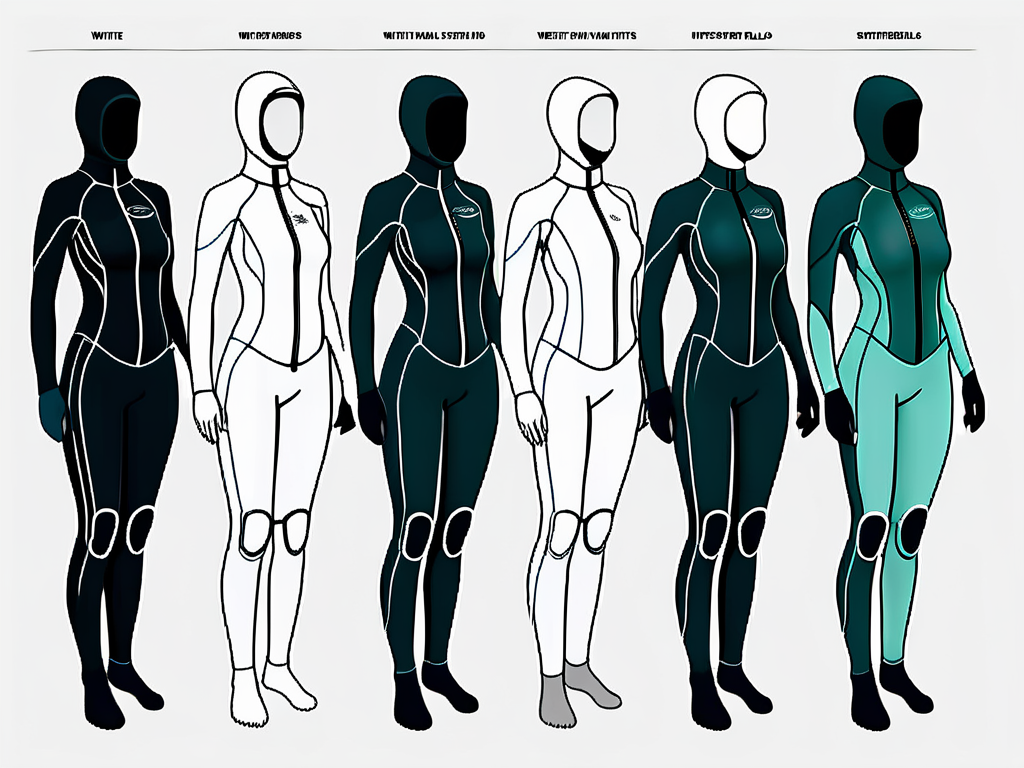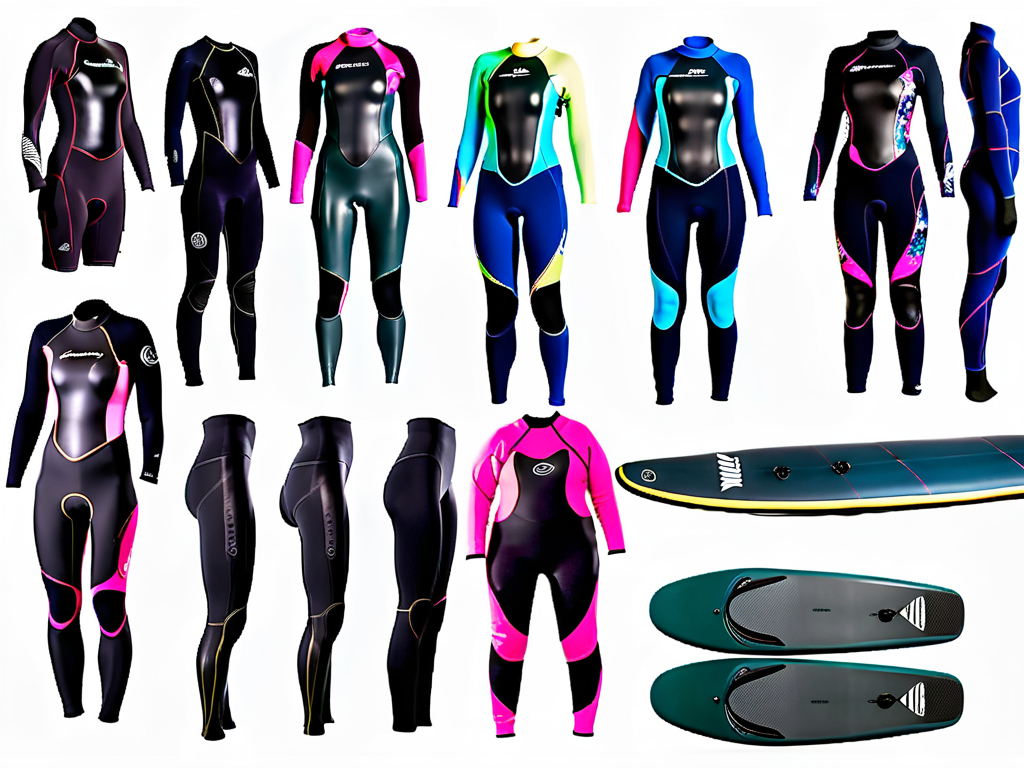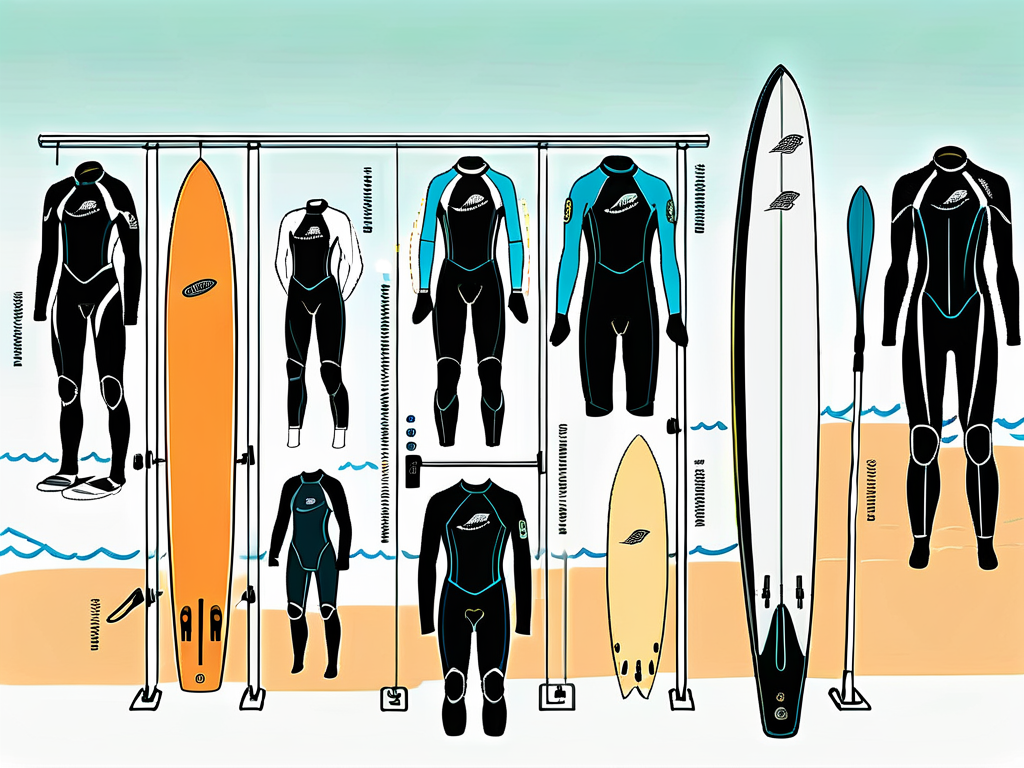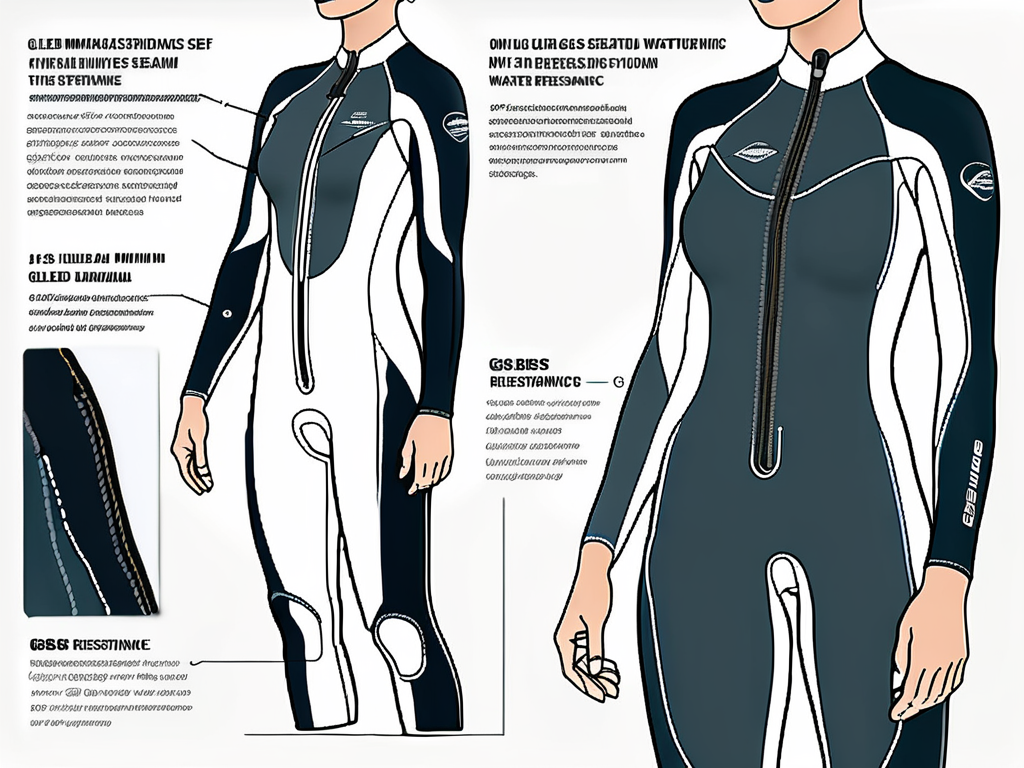The Essential Women's Wetsuit Buying Guide
When it comes to buying a women's wetsuit, there are a few key factors to consider. One of the first things you'll come across is neoprene thickness, which plays a crucial role in determining the warmth and flexibility of the suit.

Deciphering neoprene thickness might seem intimidating at first, but it's easier than you think. Most wetsuits have a thickness measurement that consists of two numbers, such as 3/2mm or 4/3mm. The first number refers to the thickness of the neoprene in the torso area, while the second number represents the thickness in the limb areas. The higher the number, the warmer the wetsuit will be.
It's worth noting that not all neoprene is created equal. Some wetsuits feature premium super stretch neoprene, which offers unparalleled flexibility and comfort in the water. This type of neoprene allows for a greater range of motion, making it ideal for activities like surfing, paddleboarding, or diving.
Another important consideration when choosing a wetsuit is the water temperature. Different water temperatures require different levels of insulation. For colder waters, a thicker wetsuit with more insulation is necessary to stay warm. On the other hand, for warmer waters, a thinner wetsuit with less insulation is more suitable to prevent overheating.
When selecting a wetsuit, it's also crucial to pay attention to the seam construction. Wetsuits with glued and blind-stitched seams provide a higher level of water resistance compared to flatlock seams. This feature helps keep you warmer by reducing water entry and increasing the overall durability of the suit.
The Complete Guide to Women's Wetsuits: Everything You Need to Know
In the world of water sports, having the right gear is essential for a safe and enjoyable experience. For women who love to surf, swim, or dive, a wetsuit is a must-have item. But with so many options available, how do you choose the perfect one? In this comprehensive guide, we will cover everything you need to know about women's wetsuits - from deciphering neoprene thickness to understanding the impact of water temperature on wetsuit selection, and much more.
The Essential Women's Wetsuit Buying Guide
When it comes to buying a women's wetsuit, there are a few key factors to consider. One of the first things you'll come across is neoprene thickness, which plays a crucial role in determining the warmth and flexibility of the suit.

Deciphering neoprene thickness might seem intimidating at first, but it's easier than you think. Most wetsuits have a thickness measurement that consists of two numbers, such as 3/2mm or 4/3mm. The first number refers to the thickness of the neoprene in the torso area, while the second number represents the thickness in the limb areas. The higher the number, the warmer the wetsuit will be.
It's worth noting that not all neoprene is created equal. Some wetsuits feature premium super stretch neoprene, which offers unparalleled flexibility and comfort in the water. This type of neoprene allows for a greater range of motion, making it ideal for activities like surfing, paddleboarding, or diving.
Another important consideration when choosing a wetsuit is the water temperature. Different water temperatures require different levels of insulation. For colder waters, a thicker wetsuit with more insulation is necessary to stay warm. On the other hand, for warmer waters, a thinner wetsuit with less insulation is more suitable to prevent overheating.
When selecting a wetsuit, it's also crucial to pay attention to the seam construction. Wetsuits with glued and blind-stitched seams provide a higher level of water resistance compared to flatlock seams. This feature helps keep you warmer by reducing water entry and increasing the overall durability of the suit.
Different Types of Women's Wetsuits
Women's wetsuits come in various styles to cater to different needs and water temperatures. Let's explore the three main types:

Full Wetsuits
A full wetsuit provides maximum coverage, extending from the neck down to the ankles. It is suitable for colder water temperatures and offers the most insulation and protection. Full wetsuits are ideal for surfing in chilly conditions or diving in colder regions.
These wetsuits are typically made from neoprene, a flexible and insulating material that traps a thin layer of water against the skin. This layer of water is then warmed by the body, providing thermal insulation in cold waters. Full wetsuits often feature sealed seams and zippers to prevent water from entering the suit, keeping the wearer warm and comfortable during extended water activities.
Spring Wetsuits
Spring wetsuits are designed for milder water temperatures. They cover the upper body, including the torso, and have short legs, ending above the knees. These wetsuits offer more freedom of movement and are commonly used in water sports during spring or fall.
Spring wetsuits are versatile options that provide some warmth and protection while allowing for increased mobility. The shorter legs make them suitable for activities that require bending at the knees, such as stand-up paddleboarding or kayaking. The thinner neoprene used in spring wetsuits also allows for quicker drying times, making them convenient for multiple water sessions in a day.
Shorty Wetsuits
Shorty wetsuits are the most minimalistic option, covering the upper body and ending at the thighs or just above the knees. They are ideal for warmer water conditions or active water sports where maximum flexibility is required, such as paddleboarding or snorkeling.
Shorty wetsuits are popular among water sports enthusiasts who prioritize freedom of movement and comfort in moderate to warm waters. The shorter arms and legs provide unrestricted mobility for activities like surfing, swimming, or snorkeling. Additionally, the reduced coverage of shorty wetsuits allows for quicker cooling in hot weather, preventing overheating during intense physical exertion in the water.
Achieving the Perfect Fit: A Guide for Women's Wetsuits
Once you have a good understanding of neoprene thickness and water temperature, it's time to focus on finding the perfect fit for your women's wetsuit. A wetsuit that fits well will ensure maximum comfort and optimal performance.
One of the most important tips for ensuring your wetsuit fits like a glove is to try it on before purchasing. Wetsuit sizing can vary between brands, so it's crucial to check the size chart and take accurate measurements of your body before making a decision.
When trying on a wetsuit, pay attention to how it feels around your shoulders, chest, and knees. The suit should be snug but not overly tight, allowing for ease of movement without excessive bunching or restriction.
Choosing the right size wetsuit is also essential. Wetsuits should fit tightly without any sagging or excess material. If it's too loose, cold water can seep in, reducing the effectiveness of the insulation. On the other hand, if it's too tight, it can restrict your movement and lead to discomfort.
Another factor to consider when selecting a women's wetsuit is the zipper style. There are two main types of wetsuit zippers: back zippers and chest zippers. Back zippers are easier to get in and out of, making them a popular choice for beginners. However, chest zippers provide a better seal and prevent water from entering the suit, offering improved insulation.
Additionally, the seam construction of a wetsuit can impact its fit and comfort. Flatlock seams are comfortable but may allow water to seep through, while sealed and taped seams provide better insulation and durability. Blindstitched seams are the most effective at preventing water entry, making them ideal for cold water conditions.
Navigating the World of Neoprene: Which Type is Right for You?
Neoprene is the material used in wetsuits, and there are different types available. Understanding the differences between regular, limestone, and Yulex neoprene will help you make an informed decision about which is right for you.
Regular neoprene is the most common type and is made from petroleum-based materials. It offers a good balance of warmth, flexibility, and durability. This type of neoprene is widely used in various water sports due to its reliable performance in different conditions. Whether you're surfing, diving, or swimming, regular neoprene can provide the protection and comfort you need to enjoy your time in the water to the fullest.
Limestone neoprene, on the other hand, is derived from limestone instead of petroleum, making it more eco-friendly. It provides excellent insulation and is known for its stretchiness. The process of creating limestone neoprene involves fewer harsh chemicals compared to regular neoprene production, making it a popular choice among environmentally conscious water enthusiasts. Its superior thermal properties make it ideal for cold water activities, ensuring you stay warm and comfortable even in chilly ocean conditions.
Yulex neoprene is made from natural rubber and is a sustainable alternative to regular neoprene. It boasts similar performance characteristics and is also highly flexible. Yulex neoprene is harvested from a certified source, ensuring that the rubber trees are sustainably managed. This type of neoprene is a great option for those looking to reduce their environmental impact without compromising on quality and functionality. Whether you're a beginner or a seasoned water sports enthusiast, choosing Yulex neoprene can align with your values of sustainability and performance.
Selecting the Ideal Entry System for Your Wetsuit
Another factor to consider when choosing a women's wetsuit is the entry system. There are several types to choose from, including front zip, back zip, chest zip, and even some wetsuits that have no zip at all.

Front zip wetsuits feature a zipper at the front, which makes them easy to put on and take off. They provide good flexibility and are a popular choice among surfers. Back zip wetsuits have a zipper at the back, offering a classic design that is easy to get into. They provide a snug fit and are often favored by divers. Chest zip wetsuits have a zip across the chest, providing a secure and watertight closure. They offer excellent flexibility and are commonly used in colder waters. Finally, some wetsuits eliminate the need for a zip altogether, using stretchy materials to create a pull-on style.
Personalizing Your Wetsuit Experience for Maximum Comfort
Every woman is unique, and so are her preferences when it comes to comfort. Personalizing your wetsuit can make a world of difference in how it feels and performs in the water.
Many wetsuits offer adjustable features such as Velcro straps, zippered ankles, or removable hoods. These features allow you to customize the fit and functionality of your wetsuit to suit your individual needs and preferences.
Additionally, some wetsuits come with added extras like reinforced knees, seamless paddle zones, or built-in hoods. These features can enhance your comfort and performance, so it's worth considering if they align with your specific requirements.
Seam Options Demystified: Finding the Perfect Match
Seams are an essential part of a wetsuit's construction, and there are different options available to choose from.
Flatlock seams are often found in entry-level wetsuits. They are created by overlapping two pieces of neoprene and stitching them together, resulting in a visible, flat stitch pattern. While flatlock seams are durable and comfortable, they can let in more water compared to other seam options.
GBS, or glued and blind stitched, seams are created by gluing the neoprene panels together and then stitching them partially from the inside. This construction method makes the seams watertight and durable. GBS seams offer excellent insulation and are typically found in higher-end wetsuits.
Taped and sealed seams take seam construction to the next level. These seams are glued, blind stitched, and then reinforced with liquid tape or neoprene tape. Taped and sealed seams provide maximum insulation and are often used in wetsuits designed for extremely cold waters.
The Benefits of GBS Seams in Wetsuits
Among the various types of seams, GBS seams are a popular choice for women's wetsuits due to their superior performance and comfort.

GBS seams offer excellent waterproofness, as the stitching does not penetrate all the way through the neoprene. This means minimal water entry, resulting in enhanced warmth and insulation.
The use of glue in GBS seams also adds strength and durability to the wetsuit, ensuring it can withstand the rigors of your water adventures. Additionally, GBS seams are less likely to cause chafing or irritation on the skin, making them more comfortable to wear for extended periods.
Extending the Lifespan of Your Wetsuit: Care and Maintenance Tips
Your women's wetsuit is an investment, and with proper care, you can extend its lifespan and enjoy it for years to come.
After each use, it's important to rinse your wetsuit with fresh water to remove salt, sand, and other debris. Hand-washing with a mild detergent is recommended, followed by thorough rinsing.
When drying your wetsuit, avoid direct sunlight or heat sources, as they can cause the neoprene to deteriorate. Instead, hang it in a shaded, well-ventilated area. Make sure to turn the wetsuit inside out to allow both sides to dry completely.
Additionally, it's essential to avoid folding or creasing your wetsuit excessively, as this can damage the material. Store it flat or hang it using a wide, padded hanger to help maintain its shape.
By following these care and maintenance tips, you can keep your women's wetsuit in optimal condition and ready for your next aquatic adventure.
In conclusion, women's wetsuits are a vital piece of equipment for water enthusiasts. By understanding the various aspects of wetsuit buying, such as neoprene thickness, water temperature, fit, neoprene type, entry system, personalization options, seam construction, care, and maintenance, you can make an informed decision and choose the perfect wetsuit that meets your individual needs and preferences. With the right wetsuit, you'll be ready to dive into the water with confidence and enjoy your favorite water sports to the fullest.
Achieving the Perfect Fit: A Guide for Women's Wetsuits
Once you have a good understanding of neoprene thickness and water temperature, it's time to focus on finding the perfect fit for your women's wetsuit. A wetsuit that fits well will ensure maximum comfort and optimal performance.
One of the most important tips for ensuring your wetsuit fits like a glove is to try it on before purchasing. Wetsuit sizing can vary between brands, so it's crucial to check the size chart and take accurate measurements of your body before making a decision.
When trying on a wetsuit, pay attention to how it feels around your shoulders, chest, and knees. The suit should be snug but not overly tight, allowing for ease of movement without excessive bunching or restriction.
Choosing the right size wetsuit is also essential. Wetsuits should fit tightly without any sagging or excess material. If it's too loose, cold water can seep in, reducing the effectiveness of the insulation. On the other hand, if it's too tight, it can restrict your movement and lead to discomfort.
Another factor to consider when selecting a women's wetsuit is the zipper style. There are two main types of wetsuit zippers: back zippers and chest zippers. Back zippers are easier to get in and out of, making them a popular choice for beginners. However, chest zippers provide a better seal and prevent water from entering the suit, offering improved insulation.
Additionally, the seam construction of a wetsuit can impact its fit and comfort. Flatlock seams are comfortable but may allow water to seep through, while sealed and taped seams provide better insulation and durability. Blindstitched seams are the most effective at preventing water entry, making them ideal for cold water conditions.
Navigating the World of Neoprene: Which Type is Right for You?
Neoprene is the material used in wetsuits, and there are different types available. Understanding the differences between regular, limestone, and Yulex neoprene will help you make an informed decision about which is right for you.
Regular neoprene is the most common type and is made from petroleum-based materials. It offers a good balance of warmth, flexibility, and durability. This type of neoprene is widely used in various water sports due to its reliable performance in different conditions. Whether you're surfing, diving, or swimming, regular neoprene can provide the protection and comfort you need to enjoy your time in the water to the fullest.
Limestone neoprene, on the other hand, is derived from limestone instead of petroleum, making it more eco-friendly. It provides excellent insulation and is known for its stretchiness. The process of creating limestone neoprene involves fewer harsh chemicals compared to regular neoprene production, making it a popular choice among environmentally conscious water enthusiasts. Its superior thermal properties make it ideal for cold water activities, ensuring you stay warm and comfortable even in chilly ocean conditions.
Yulex neoprene is made from natural rubber and is a sustainable alternative to regular neoprene. It boasts similar performance characteristics and is also highly flexible. Yulex neoprene is harvested from a certified source, ensuring that the rubber trees are sustainably managed. This type of neoprene is a great option for those looking to reduce their environmental impact without compromising on quality and functionality. Whether you're a beginner or a seasoned water sports enthusiast, choosing Yulex neoprene can align with your values of sustainability and performance.
Selecting the Ideal Entry System for Your Wetsuit
Another factor to consider when choosing a women's wetsuit is the entry system. There are several types to choose from, including front zip, back zip, chest zip, and even some wetsuits that have no zip at all.

Front zip wetsuits feature a zipper at the front, which makes them easy to put on and take off. They provide good flexibility and are a popular choice among surfers. Back zip wetsuits have a zipper at the back, offering a classic design that is easy to get into. They provide a snug fit and are often favored by divers. Chest zip wetsuits have a zip across the chest, providing a secure and watertight closure. They offer excellent flexibility and are commonly used in colder waters. Finally, some wetsuits eliminate the need for a zip altogether, using stretchy materials to create a pull-on style.
Personalizing Your Wetsuit Experience for Maximum Comfort
Every woman is unique, and so are her preferences when it comes to comfort. Personalizing your wetsuit can make a world of difference in how it feels and performs in the water.
Many wetsuits offer adjustable features such as Velcro straps, zippered ankles, or removable hoods. These features allow you to customize the fit and functionality of your wetsuit to suit your individual needs and preferences.
Additionally, some wetsuits come with added extras like reinforced knees, seamless paddle zones, or built-in hoods. These features can enhance your comfort and performance, so it's worth considering if they align with your specific requirements.
Seam Options Demystified: Finding the Perfect Match
Seams are an essential part of a wetsuit's construction, and there are different options available to choose from.
Flatlock seams are often found in entry-level wetsuits. They are created by overlapping two pieces of neoprene and stitching them together, resulting in a visible, flat stitch pattern. While flatlock seams are durable and comfortable, they can let in more water compared to other seam options.
GBS, or glued and blind stitched, seams are created by gluing the neoprene panels together and then stitching them partially from the inside. This construction method makes the seams watertight and durable. GBS seams offer excellent insulation and are typically found in higher-end wetsuits.
Taped and sealed seams take seam construction to the next level. These seams are glued, blind stitched, and then reinforced with liquid tape or neoprene tape. Taped and sealed seams provide maximum insulation and are often used in wetsuits designed for extremely cold waters.
The Benefits of GBS Seams in Wetsuits
Among the various types of seams, GBS seams are a popular choice for women's wetsuits due to their superior performance and comfort.

GBS seams offer excellent waterproofness, as the stitching does not penetrate all the way through the neoprene. This means minimal water entry, resulting in enhanced warmth and insulation.
The use of glue in GBS seams also adds strength and durability to the wetsuit, ensuring it can withstand the rigors of your water adventures. Additionally, GBS seams are less likely to cause chafing or irritation on the skin, making them more comfortable to wear for extended periods.
Extending the Lifespan of Your Wetsuit: Care and Maintenance Tips
Your women's wetsuit is an investment, and with proper care, you can extend its lifespan and enjoy it for years to come.
After each use, it's important to rinse your wetsuit with fresh water to remove salt, sand, and other debris. Hand-washing with a mild detergent is recommended, followed by thorough rinsing.
When drying your wetsuit, avoid direct sunlight or heat sources, as they can cause the neoprene to deteriorate. Instead, hang it in a shaded, well-ventilated area. Make sure to turn the wetsuit inside out to allow both sides to dry completely.
Additionally, it's essential to avoid folding or creasing your wetsuit excessively, as this can damage the material. Store it flat or hang it using a wide, padded hanger to help maintain its shape.
By following these care and maintenance tips, you can keep your women's wetsuit in optimal condition and ready for your next aquatic adventure.
In conclusion, women's wetsuits are a vital piece of equipment for water enthusiasts. By understanding the various aspects of wetsuit buying, such as neoprene thickness, water temperature, fit, neoprene type, entry system, personalization options, seam construction, care, and maintenance, you can make an informed decision and choose the perfect wetsuit that meets your individual needs and preferences. With the right wetsuit, you'll be ready to dive into the water with confidence and enjoy your favorite water sports to the fullest.



















